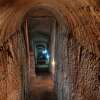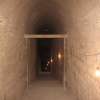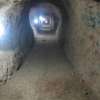History of Dosangi Mill ( Two-stone Mill )
Dosangi water mill is located in a village named Mohammad Abad in Meybod. It is about 200 years old dating back to Qajar era. In 2011, it was registered as a national Iranian Monument with registration no. 29985.
Dosangi Mill is the deepest water mill under the ground which is unique in the world. Moreover, it also has some architectural unique features which make it special such as underground rooms, their placement on the crossed way of two main qanat tunnels, and etc.
.jpg)
The Architecture of Dosangi Water Mill
This water mill has a corridor with the length of 140 meters and lies in a depth of 40 meters under the ground. It is very cold and pleasant. This masterpiece has been built by creative and intelligent people of Meybod who did it all by hand. So we can introduce it as a very good tourist attraction in Meybod.
No construction material has been used in the construction of this water mill. There are wells with a depth of 40 meters below it that provide the lighting and air conditioning of the interior space of the mill.
The stones installed in the mill are very hard and solid made of a combination of acid and volcanic roots and they were brought from Mount Ernan. After rolling and polishing, these rocks were mounted on two donkeys and were installed in their current position with specific ceremonies.
The entrance path of Dosangi Mill starts from behind the wall of Mohammad Abad village and after passing a 2-meter long slope below the wall, it enters the inner staircase of a vestibule and goes to a four-door chamber.
.jpg)
How the water mill works?
In Dosangi Mill, the water firstly enters a pond in order to be purified and cleaned. In old times, this pond was used as a pool for taking a bath. The water passes through the lid at the end of the pond, then enters a large vertical stone tank to be accumulated and to have pressure while exiting the tank. The water exits with great force, hits the wooden blades, and rotates them.
The wheat is brought to the middle of the stones, then it goes to the hole at the center, it exactly lies between the two round stones, the underlying stone is always fixed and the above stone turns; thus, the wheat grains trapped between the two stones gradually turn into flour. Then the water entering the mill, exits through the opening at the end of the mill and goes to the farms.
.jpg)
To book a room in Meybod or reserve a sightseeing tour, contact Raadina Travel Agency for the best offer and best price.
Online Support















.jpg)
.jpg)
.jpg)
